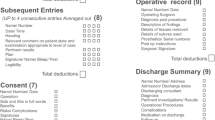Abstract
Background
To provide safe and effective patient care, records must be kept in a high-quality manner. Clinical audits should be conducted on a frequent basis to ensure that high standards of record-keeping are upheld. An audit and re-audit of the surgical inpatient records’ documentation were conducted as part of a retrospective, descriptive study to see if it aligns with the hospital’s stated policy.
Aims/objectives
Evaluating the hospital’s present documentation process and considering how current practice could be improved were the key objectives of the audit project.
Method
An interactive form was created to audit the criteria using standard hospital guidelines as a foundation. Retrospective analysis of 120 case files served as the main source for the information gathered. The documentation in the records was evaluated to determine whether it was accurate and complete in every section. The data was collected, analyzed, and presented at clinical governance. These outcomes were implemented in our documentation protocol in a way that all surgical personnel are given instructions on the appropriate documentation and how to complete it. This data was again, prospectively collected to complete the audit cycle.
Results
Thirty-five of the 37 relevant audit standards witnessed an increase in compliance. No standard or criterion’s compliance dropped during the re-audit cycle. Since the first audit cycle, compliance has increased on average by 32% across all audit criteria, suggesting that some of the work done after the first cycle has had a significant effect.
Discussion/conclusions
Record-keeping must be considered as an integral part of medical practice; current documentation work demonstrates that when performed appropriately, audit can actually affect the quality of clinical records. The audit itself can increase awareness of the need for practice improvement. The distribution of findings, instruction, training, and local action planning are all essential for developing practice.
Similar content being viewed by others
Availability of data and materials
All data generated or analyzed during this study were included in this published article although some data that support the findings of this study are available from Ribat University Hospital authority. Restrictions are applied to the availability of these data, which were used under license for the current study, and so are not publicly available. Data are however available from the author upon reasonable request and with permission of (RUH authority).
References
Chamisa I, Zulu BM (2007) Setting the records straight: a prospective audit of the quality of case notes in a surgical department. S Afr J Surg 45(3):92, 94–95
Desalu I, Olanipekun O, Agbamu P (2010) An audit of anaesthesia record keeping at the Lagos University Teaching Hospital. Afr J Anaesth Int Care 10(1):1–5. https://www.ajol.info/index.php/ajaic/article/view/60591
Dosumo EB, Dosumo OO, Lawal FB (2012) Quality of records keeping undergraduate dental students in Ibadan. Nigéria Ann Ib Postgrad Med 10(1):13–17
Kediegile G, Madzimbamuto FD (2014) Obstacles faced when conducting a clinical audit in Botswana. South Afr J Anaesth Analg 20(2):127–131. https://www.ajol.info/index.php/sajaa/article/view/105673
Maegga BT, Cox J, Malley KD (2005) Malaria in the southern highlands of Tanzania: a review of hospital records. Tanzan Health Res Bull 7(3):125–132
Omigbodun AO (2004) Improving standards in practice through medical audit. Ann Ib Postgrad Med 1(2):23–26. https://www.ajol.info/index.php/aipm/article/view/39084
Author information
Authors and Affiliations
Contributions
ElMuhtadi Gasoma: Involved in study design, data acquisition, drafting the article, revising it critically, and finally approved the manuscript.
Corresponding author
Ethics declarations
Ethics approval and consent to participate
The ethical approval was obtained from the ethics committee of Ribat University Hospital authority on 13/2/2022 no. 111/52. Experimental protocols were approved by the Ribat University Hospital authority licensing committee and the study protocol was performed in accordance with the relevant guidelines applied at the hospital. The data used in the study is anonymized. The informed consent waiver was approved by the ethics committee of Ribat University Hospital authority.
Conflict of interest
The author declares no competing interests.
Additional information
Publisher's Note
Springer Nature remains neutral with regard to jurisdictional claims in published maps and institutional affiliations.
Rights and permissions
Springer Nature or its licensor (e.g. a society or other partner) holds exclusive rights to this article under a publishing agreement with the author(s) or other rightsholder(s); author self-archiving of the accepted manuscript version of this article is solely governed by the terms of such publishing agreement and applicable law.
About this article
Cite this article
Gasoma, E.B.Y. Retrospective audit in documentation practice in surgical inpatients records, a two cycles audit. Ir J Med Sci 192, 2345–2349 (2023). https://doi.org/10.1007/s11845-022-03224-2
Received:
Accepted:
Published:
Issue Date:
DOI: https://doi.org/10.1007/s11845-022-03224-2




